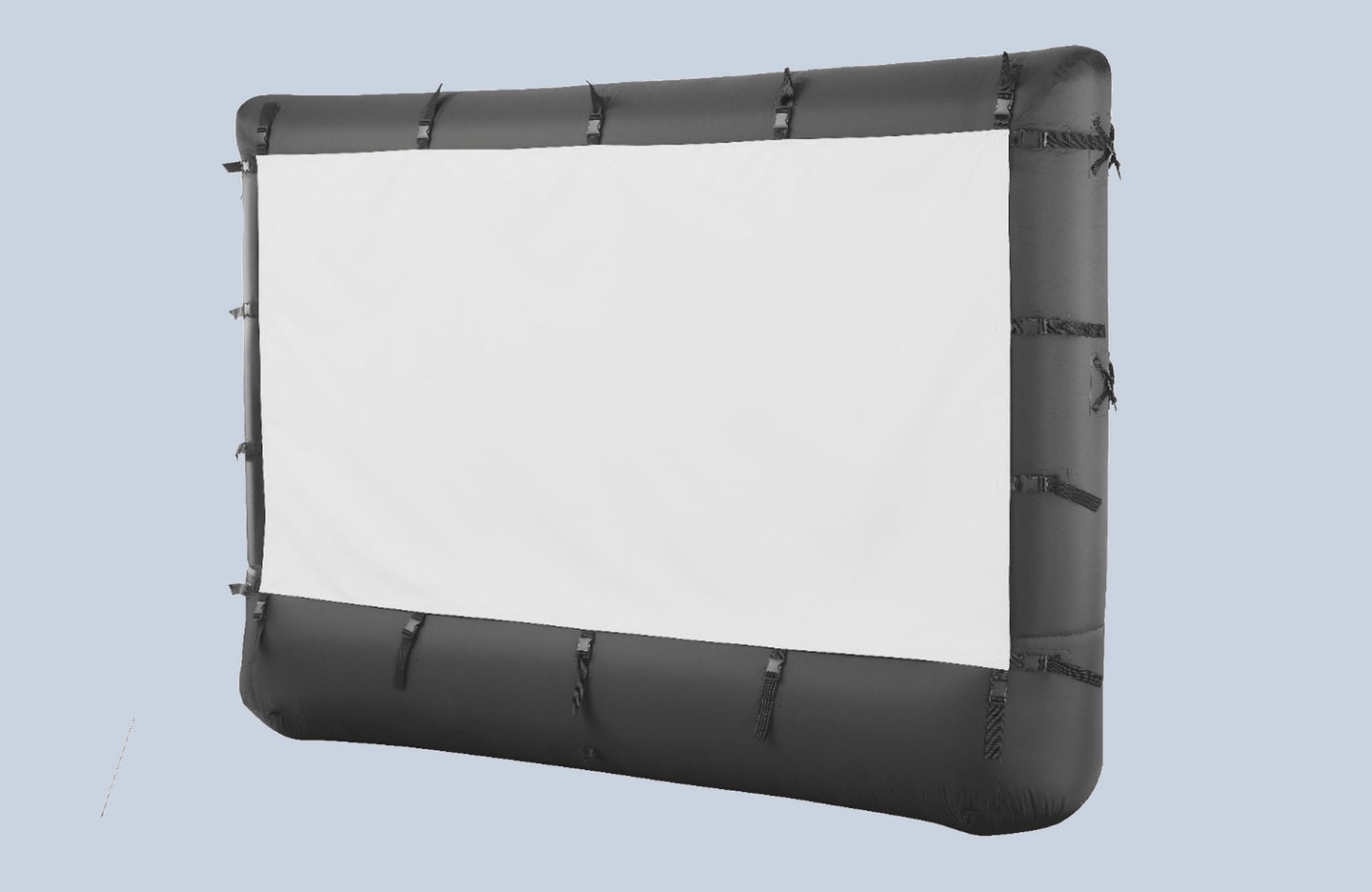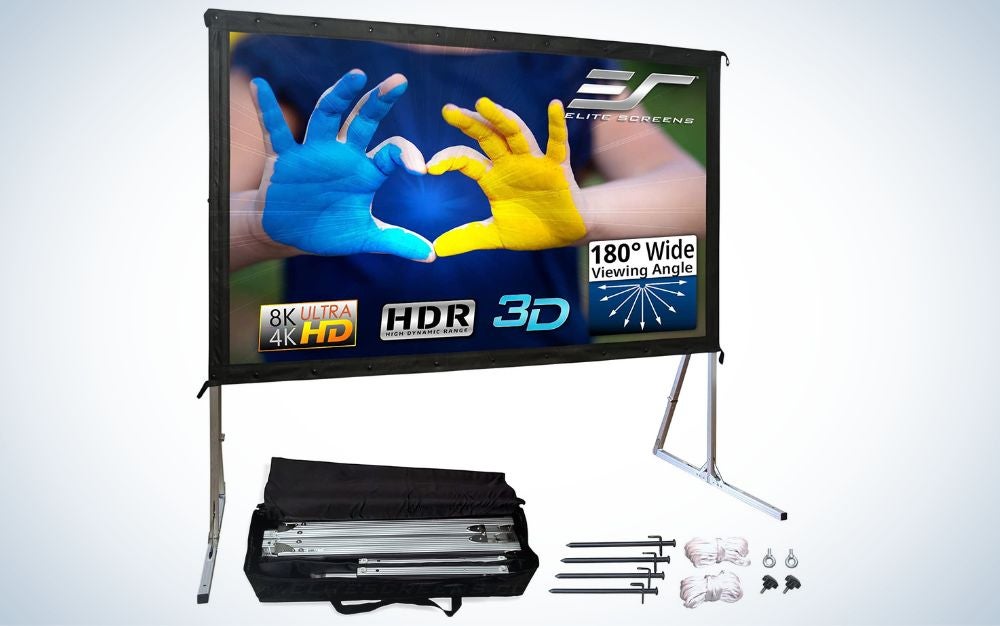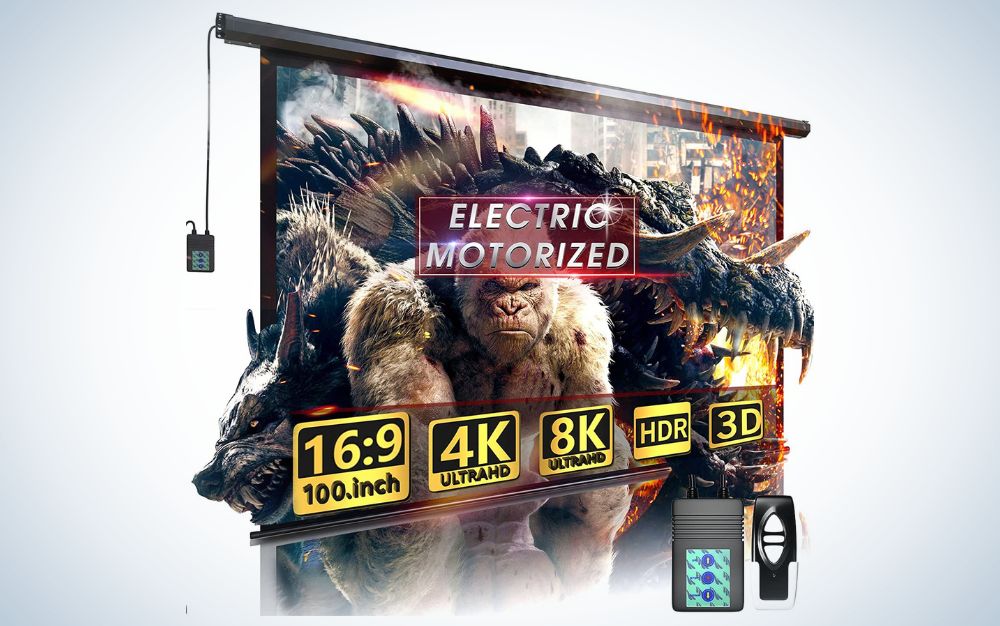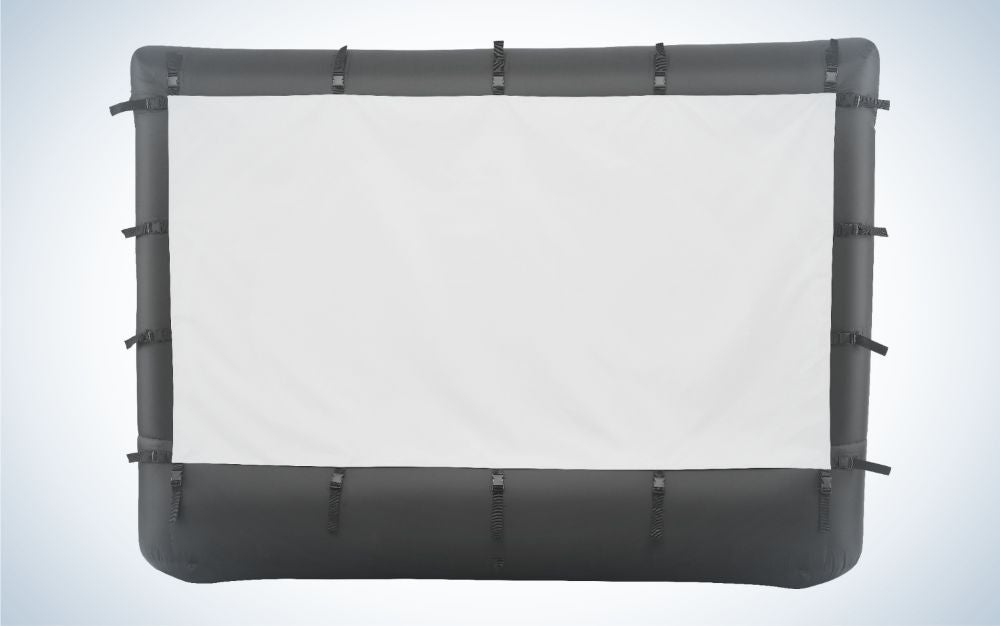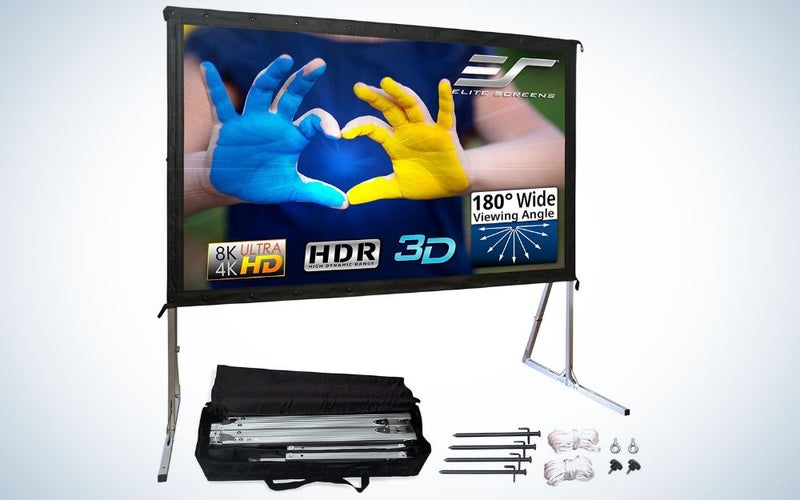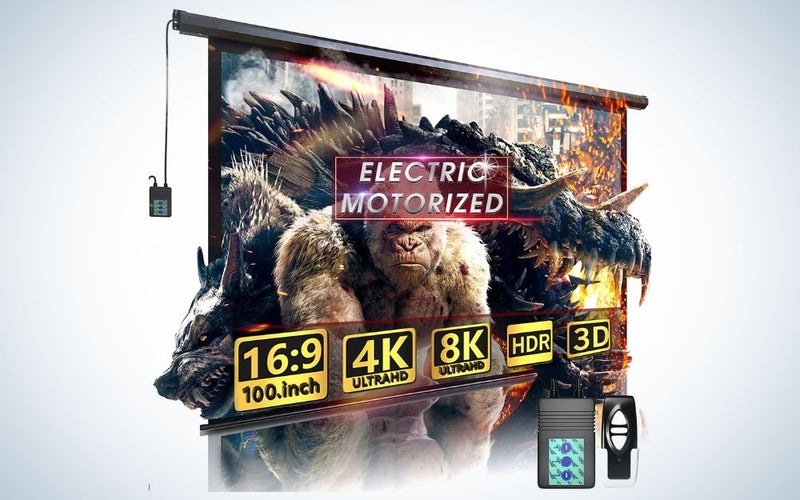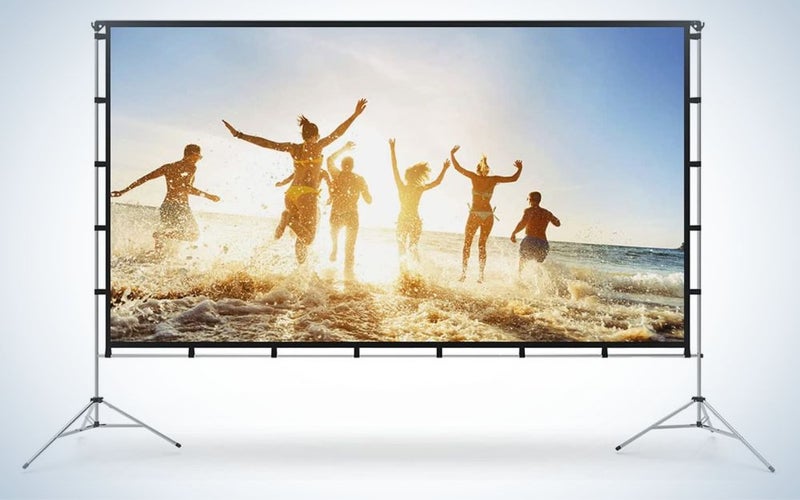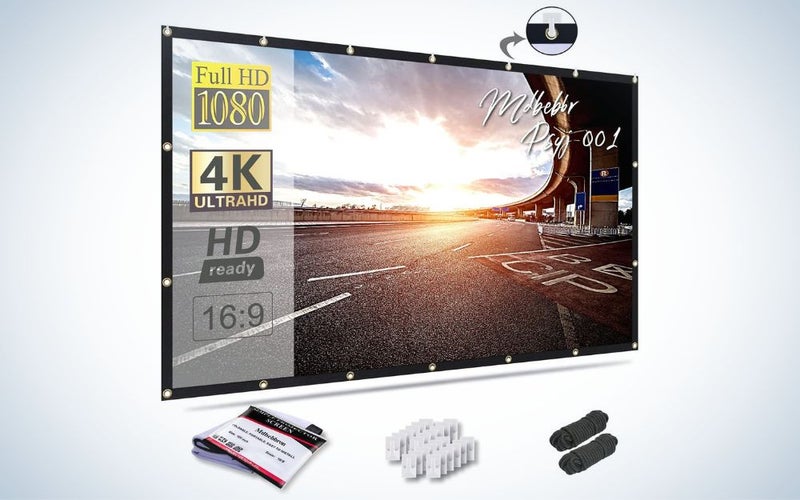We may earn revenue from the products available on this page and participate in affiliate programs. Learn more ›
Outdoor project screens can turn a backyard—or any outside space—into a great spot to hangout with family and friends. With an outdoor projector setup, you can keep the party where the grill is and put on the baseball game so you don’t miss a pitch. It’s also the perfect way to host an epic movie night. Simply put up the screen, pop the popcorn, and get out the lawn chairs and blankets, or maybe even a kiddie pool full of pillows. With so many different streaming options, it is simple to put on your favorite movie through a projector. For photographers, they can also be a great way to show off work by throwing an impromptu exhibition just about anywhere. The best outdoor projector screens will make you the star of the neighborhood and your friends.
- Best overall: Elite Screens Yard Master 2 120-inch Outdoor Projector Screen
- Best motorized: Aoxun 100″ Motorized Projector Screen
- Best inflatable: Insignia™ – 114″ Outdoor Projector Screen
- Best portable: Vamvo 120 inch Portable Foldable Projection Screen
- Best budget: Mdbebbron 120 inch Projection Screen
How we picked the best outdoor projector screens
When selecting the best outdoor projector screens, we aimed to choose a variety of stand types that would suit different setup needs. Whether you have a situation that allows you to leave the screen up permanently or you need to be able to travel with it, we made sure to include something that would work. The quality of the screen, in part controlled by materials and screen layers, was one of the primary considerations. And as always, choosing products at different price points was important.
The best outdoor projector screens: Reviews & Recommendations
Best overall: Elite Screens Yard Master 2 120-inch Outdoor Projector Screen
Elite Screens
Why it made the cut: The Yard Master 2 comes in a range of sizes from 58 to 135 inches in either 4:3 or 16:9 aspect ratio, is made of an easy to clean PVC material, and it’s easy to assemble.
Key features
- Screen size: 120 inches (also comes in 58, 75, 90, 100, 110, and 135-inch versions)
- Gain: 1.3
- Stand material: Aluminum
- Assembled size: 88.9 x 109.8 x 36.7 inches
Pros
- Lots of size options
- Great picture quality
- Black backing for less light penetration
- 8K ready
- Screen can be cleaned with soap and water
Cons
- Prone to wrinkles
The Elite Screens Yard Master 2 is a well-rounded screen with lots of great features at a reasonable price. This particular model has a 120-inch screen size with a 16:9 aspect ratio. This screen also comes in many different sizes should you want something smaller or larger. It also is available in a 4:3 ratio if that suits your needs better.
The screen is made of a very durable and smooth PVC material. It’s fully waterproof, so if you happen to have it up during an epic water gun fight, you don’t need to panic. And, if it should get dirty, you can wipe it down with soap and water. The legs are lightweight aluminum with stainless steel hinge plates and pins, making them rust and corrosion resistant. It’s plenty sturdy, but it does come with ground stakes and rigging cords just in case the wind picks up. And it’s very easy to assemble, keeping you from spending your afternoon getting it set up.
The screen itself is of great quality with little texture. It has a black backing for better brightness and contrast. The 1.3 gain is an ideal balance between better brightness without losing out on viewing angles. In fact, this screen has a 180-degree viewing angle, though don’t expect perfect performance if you’re sitting way off to the side. You can spread out on the yard while watching and still have an excellent viewing experience. It is ISF certified, meaning it will provide accurate colors. It is a bit prone to wrinkling, but that shouldn’t be much of a problem if you store it carefully.
Best motorized: Aoxun 100″ Motorized Projector Screen
Aoxun
Why it made the cut: If outdoor viewing parties are a regular thing, this 100-inch motorized screen allows you to mount it to a wall or ceiling and use a remote to tuck it away when not in use.
Key features
- Screen size: 100 inches (also available in 110 and 120-inch versions)
- Gain: 1.2
- Stand material: Steel
- Assembled size: 88.98 x 57.87 inches with the screen down
Pros
- Easy to install
- Four-layer screen for excellent image quality
- Quiet motor
- Wireless remote or control box operated
Cons
- Requires a wall or ceiling for mounting
If you want a more permanent solution for your outdoor projector, the Aoxun 100-inch Motorized Projector Screen is a fantastic option. The steel case easily mounts to either a wall or ceiling, so you won’t have to get it out and set it up every time you want to watch something outside. It’s definitely a great companion to larger covered porches. However, due to the size, the recommended viewing angle is 10 feet, so you won’t want to use this on apartment-sized decks or other similar spaces.
The screen consists of four layers. It has a black backing layer to prevent light penetration, a glass fiber layer to help with picture clarity, an anti-light layer to improve image quality, and a protective layer that makes it easy to clean. All of this results in exceptional image quality suitable for up to 8K videos. It also has a gain of 1.2 for great contrast but a wide viewing angle of 160 degrees.
The motor is quiet and provides smooth raising and lowering of the screen. It’s also quiet, less than 42 decibels, so you won’t wake up the neighborhood if you raise the screen after a late night movie. You can control it via a wireless remote or a wall-mountable control pane. An ideal situation in case the remote gets lost. And you can choose how far the screen comes down, so if you want something other than a 16:9 ratio, you can simply lower it less.
This motorized option does require a wall or ceiling space for mounting, so it’s not going to be portable or able to be set up in the middle of your yard. And there is no tension on the screen, so wind may impact things while watching a movie. But, for a large motorized screen with excellent display qualities at such a reasonable price, you can’t go wrong if you have the space.
Best inflatable: Insignia™ – 114″ Outdoor Projector Screen
Insignia™
Why it made the cut: This inflatable screen has a large 83 by 115-inch screen size and includes an air pump that fully inflates in seconds and a carrying case for easy transportation.
Key features
- Screen size: 114 inches
- Gain: Not provided
- Stand material: Not provided
- Assembled size: 83 × 115 × 25 inches
Pros
- Thick material for better image quality
- Large screen
- Fast inflation
- Air blower is quiet
Cons
- Air blower has to be constantly running when assembled
- Prone to wrinkles
Inflatable projector screens are excellent options because of how easy they are to assemble. For the most part, you simply start the motorized air pump and let it do its thing.
This inflatable screen from Insignia is excellent if you want something inflatable. It has a large 114-inch diagonal, resulting in a viewing area of 83 by 115 inches. It comes with ground steaks so that you can tie it down in case the weather turns on you. And it can handle some light rain as well.
The air pump does have to continuously run when you are watching, which introduces some noise. But the motor is quiet, so as long as you have some decent speakers for your projector, you won’t have issues hearing over it. The screen is made of a thick material to improve brightness and contrast. It is prone to showing creases from folding, but those should lessen with repeated use with the screen stretched taut.
Best portable: Vamvo 120 inch Portable Foldable Projection Screen
Vamvo
Why it made the cut: This projector screen weighs only 6.95 when packed in the small carrying case, making it easy to bring wherever you need your movie night.
Key features
- Screen size: 120 inches (also comes in 80 and 100 inch versions)
- Gain: Not provided
- Stand material: Aluminum
- Assembled size: 107 x 70.9 inches
Pros
- Easy to assemble
- Comes with a small carrying case
- Polyester screen material can be ironed to reduce wrinkles
- Supports front and rear projection
Cons
- Screen doesn’t have a black backing
- Stand can be wobbly without tying it down
Sometimes movie night doesn’t happen in your backyard. Maybe you want to go over to a friend’s house, bring a projector to camp, or set up a party in a park. This Vamvo 120-inch Portable Foldable Projection Screen is an ideal solution. The screen folds down to just 22 by 14 inches, and all pieces of the stand and screen fit inside the included carrying case. With all packed up, it weighs only 6.95 pounds and is only 22 x 12.2 x 4.7 inches, making it easy to throw in your car or even a backpack.
The stand features an elastic cord inside all the posts, sort of like tent poles. It makes it extremely easy and quick to assemble, keeping you from fussing around with it for hours. It also comes with ground stakes to tie it down for added stability when outside.
The screen is made of polyester material. It is wrinkle-resistant, but you can take an iron to it to smooth everything out should it get wrinkles. There is no backing, and it isn’t fully opaque, so some light from the projector will cut through it, reducing brightness and contrast slightly. But, it does enable you to use either front or rear projection, which is nice to have. It won’t give you the highest picture quality, but it is an excellent choice for the price and portability.
Best budget: Mdbebbron 120 inch Projection Screen
Mdbebbron
Why it made the cut: This highly affordable option has a 120-inch diagonal size with a 16:9 aspect ratio. It’s wrinkle-resistant, and machine washable should it need cleaning.
Key features
- Screen size: 120 inches
- Gain: 1.1
- Stand material: Not applicable – no stand provided
- Assembled size: 104 x 58 inches
Pros
- Comes with ropes and adhesive-based hooks for hanging
- Large screen size
- Wrinkle-resistant material
- Can be machine washed if needed
- Very affordable
Cons
- Doesn’t include a stand
If you want a simple, straightforward projector screen option for your outdoor watch parties, this Mdbebbron 120-inch Projection Screen is ideal. It provides a large viewing area of 104 by 58 inches for an immersive experience and a 16:9 aspect ratio.
Part of the reason for the low price of this screen is that it doesn’t come with a stand. However, it does come with ropes and hooks that use double-sided adhesive. You’ll either need to build a stand–PVC pipes are an easy option–or have wall space to mount the screen.
The screen is made of wrinkle-resistant polyester. As with the portable option, the polyester material means you will lose out on some brightness since there is no backing, and light will seep through. But, it is lightweight and can be machine or hand washed should it get dirty. You can also iron it at a low heat if you want to ensure there are no wrinkles.
It may not be the fanciest option on the list, but the low price makes it very enticing for those looking to use it occasionally.
Things to consider before buying the best outdoor projector screens
Outdoor projector screens are mostly simple pieces of equipment. They are nothing more than a piece of fabric and frequently a frame of some sort. While there aren’t crazy technical specs to pay attention to when buying a projector screen, there are some things you’ll want to look out for and consider before spending your hard-earned money. Otherwise you may pair a fantastic projector with a less than fantastic screen, resulting in a subpar viewing experience.
Size
Size is perhaps the most obvious thing to think about when buying a projector screen. Like any display device, there will be an optimal viewing distance and viewing angles for projector screens. You don’t want to get the largest screen possible for your tiny backyard and have to sit right in front of it. You want to measure the area in which you plan to put your screen before buying one to be sure it will fit and that you have room to sit back the proper amount.
The other key piece to consider related to size involves your projector. If you already have a projector, you’ll want to check its throw distance and maximum projection size. Throw distance relates to how close the projector needs to be to the projector screen. It will impact how large of an image the projector can create as well. If you buy a 140-inch screen, but the projector can only project an 80-inch image, you’ll have lots of wasted space. On the flip side, if you project larger than your projector is intended to, you won’t get as much brightness and may be able to see prominent pixel structure. Verify that the project you have–or are considering–can match up with the projector screen size you want to ensure a quality viewing experience.
Aspect ratio
These days, most media content is in a 16:9 aspect ratio, yet not all projector screens will be the same. For some, white space on the top and bottom won’t matter. Or, maybe you stream different types of content with different aspect ratios, so you want something more versatile. But, if you want to fill the entire screen and only play 16:9 content, look for a projector screen with the same aspect ratio.
Material
The screen material will play a significant role in the quality of your image. While you can, of course, hang a white bedsheet up, the material’s translucent nature will result in a very low-quality image. You’ll lose out on brightness and contrast. Instead, look for a screen that is totally opaque and ideally has a black backing to prevent any light from going through it. PVC is one of the most common materials for quality screens because it blocks light very well.
PVC is also preferred because it is a smooth surface. A heavily textured surface will reduce the image quality, making your movies and shows less sharp. Be sure to get a screen made of a smooth, low texture surface for better quality.
Gain
Gain is another factor that is extremely important when it comes to quality. The measurement of gain can get a bit complicated and in the weeds. To put it simply, it is a number that represents the ratio of light reflecting off the screen compared to light reflecting off a standard white (magnesium oxide) board. For example, a screen that reflects the same amount of light as the white board will have a gain of 1.0.
High gain may seem like the best option, but that isn’t always the case. Gain also impacts viewing angles and hot-spotting (when the center is brighter than the rest). A high gain screen will be more limited in viewing angles and have a worse hotspot, especially when you get over 1.3. People seated on the edges of the screen will see less brightness than those in the center, which isn’t ideal. However, high gain screens are good in situations where there is some ambient light. A balance is definitely needed when it comes to gain, so look for something between 1.0 and 1.3 for outdoor viewing.
Assembly
The last piece of the puzzle with outdoor projector screens is how much assembly you want to do. Some screens are more simple to set up than others. If you plan on taking a screen down after every use but will be using it frequently, you’ll likely want to get something that doesn’t require much setup. A wall-mounted motorized screen may be best for situations like that, provided you don’t mind mounting it to the outside of your house. There are also some stands that are quick and easy to set up, should that be more your cup of tea.
FAQs
Q: How much do outdoor projector screens cost?
If you’re looking for the cheapest model, you can get a very basic screen for less than $50. Most stand-along options will set you back $150 or more. If you really want to get fancy with it, there are custom-installed versions out there that can run thousands of dollars. You have to really be committed to watching Shrek outdoors to get one of those, though.
Q: What color screen is best for an outdoor projector?
A white screen is best for an outdoor projector. It will reflect more light, give you more accurate colors and contrast, and provide better viewing angles compared to a gray screen when used outdoors.
Q: Can projector screens be left outside?
Projector screens can be left outside, depending on the materials they are made from. Many outdoor projector screens are made from PVC materials with metal frames, making them waterproof and resistant to rust. The PVC material also means you can wipe them down should they get dirty. But, of course, if left in direct sunlight or harsh conditions such as cold temperatures, the screen may be at risk of cracking.
Q: What size outdoor projector screen do I need?
What size outdoor projector screen you need depends on a few things. Your projector will be the main determining factor, as it will have an optimal projection size. Where you intend to put the screen also makes a difference, as there is an ideal seating distance for screen sizes. It’s also a matter of personal preference. If you have room to sit back a ways and your projector can handle it, a 120-inch outdoor projector screen is a nice large size for immersive viewing.
Q: How many lumens do I need for an outdoor projector?
How many lumens you need for an outdoor projector will depend on how far away the projector will be and how much ambient light you will usually have while watching. Of course, brighter conditions will require more lumens as the projector will have to overpower the ambient light. But, in general, 3,000 ANSI lumens will be an ideal amount for an outdoor setting.
Final thoughts on the best outdoor projector screens
- Best overall: Elite Screens Yard Master 2 120-inch Outdoor Projector Screen
- Best motorized: Aoxun 100″ Motorized Projector Screen
- Best inflatable: Insignia™ – 114″ Outdoor Projector Screen
- Best portable: Vamvo 120 inch Portable Foldable Projection Screen
- Best budget: Mdbebbron 120 inch Projection Screen
Finding an outdoor projector screen that is right for you depends on your space and what projector you will be using. You’ll want to find a screen size that works well with both aspects, and also consider how often you’ll need to assemble the screen to save yourself some headaches down the line.
Why trust us
PopPhoto has a long history of delivering the opinions of some of the sharpest and most prolific camera dorks the world has to offer. Since 1937, we’ve been reviewing cameras, providing wisdom from well-known photographers, and generally just nerding out about all that goes into making great pictures. Our current crop of writers and editors have decades of professional photography and camera writing experience among them. Collectively, we’ve probably shot with just about every camera and lens combo you can imagine—as well as some obscure stuff you may not even know about. Remember the Casio Tryx folding camera? PopPhoto does.
We also get that buying a camera is a big decision, which is why we’re dedicated to helping folks choose the right one (or, in our case “ones”) for their needs. Case in point: Handing over top dollar for an expensive rig may leave you unsatisfied if it doesn’t fit your preferred shooting style. Sure, a $6,000 sports-oriented DSLR can capture landscapes, but do you really need to do it at 30 frames-per-second? No, you don’t.
